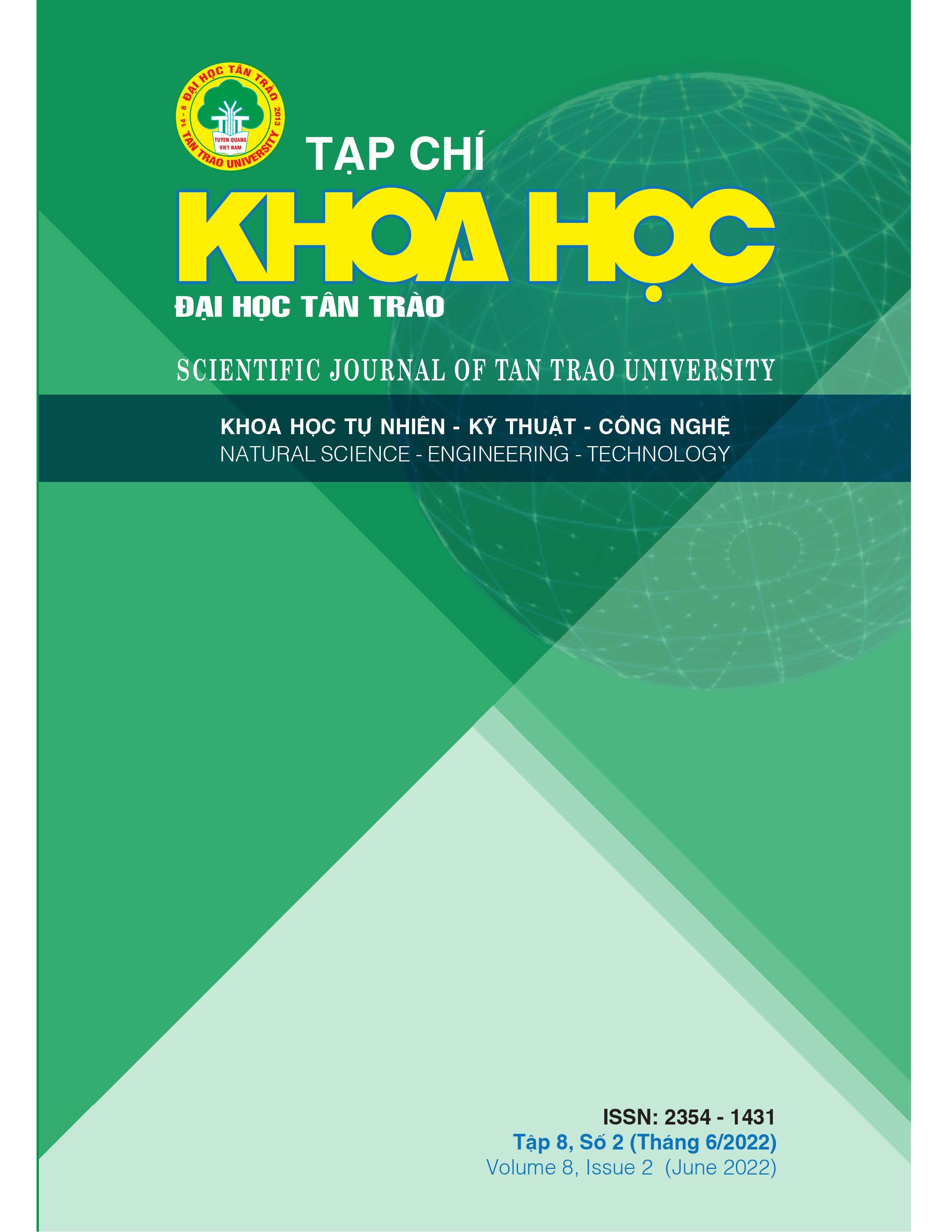NGHIÊN CỨU THÀNH PHẦN HÓA HỌC VÀ HOẠT TÍNH SINH HỌC CỦA DẦU TINH DẦU QUẾ TRÈN TẠI BẢO LẠC, TỈNH CAO BẰNG
DOI:
https://doi.org/10.51453/2354-1431/2022/758Từ khóa:
Cinnamomum Burmannii, tinh dầu, GC-MS, Cao Bằng, IC50Tóm tắt
Mục tiêu của đề tài là khảo sát thành phần hóa học và hoạt tính sinh học của tinh dầu Quế ở tỉnh Cao Bằng. Sử dụng phương pháp chưng cất lôi quốn hơi nước để chiết xuất tinh dầu. Thành phần hóa học của tinh dầu được xác định bằng phương pháp sắc ký khí ghép khối phổ (GC-MS). Đánh giá khả năng chống oxy hóa của tinh dầu Cinnamomum burmannii bằng phương pháp gốc tự do DPPH. Kết quả nghiên cứu này đã xác định tinh dầu Cinnamomum burmannii có 23 thành phần hợp chất hóa học với các thành phần chính gồm: Citronellal (52,82%), Citronellol (25,13%), 1,8-Cineole (5,04%). Tinh dầu Cinnamomum burmannii có khả năng chống oxy hóa với giá trị IC50 = 12,03 μg / ml. Những kết quả này đã tạo cơ sở để tiếp tục nghiên cứu, phát triển các sản phẩm chức năng, chăm sóc sức khỏe từ các thành phần hóa học của loại cây này.
Tải xuống
Tài liệu tham khảo
[1] Al-Dhubiab, B. E. (2012). Pharmaceutical applications and phytochemical profile of Cinnamomum burmannii. Pharmacognosy reviews, 6(12), 125.
[2] Atti-Santos, A. C., Rossato, M., Serafini, L. A., Cassel, E., & Moyna, P. (2005). Extraction of essential oils from lime (Citrus latifolia Tanaka) by hydrodistillation and supercritical carbon dioxide. Brazilian Archives of Biology and Technology, 48(1), 155-160.
[3] Berry, Paul E. và Sampson, F. Bruce. "Laurales". Encyclopedia Britannica , ngày 28 tháng 8 năm 2019, https://www.britannica.com/plant/Laurales.
[4] Cardoso-Ugarte, G. A., López-Malo, A., & Sosa-Morales, M. E. (2016). Cinnamon (Cinnamomum zeylanicum) essential oils. In Essential oils in food preservation, flavor and safety (pp. 339-347). Academic Press.
[5] Cardoso-Ugarte, G. A., López-Malo, A., & Sosa-Morales, M. E. (2016). Cinnamon (Cinnamomum zeylanicum) essential oils. In Essential oils in food preservation, flavor and safety (pp. 339-347). Academic Press.
[6] Chandurkar, P., Tripathi, N., Choudhary, A., & Murab, T. (2014). Antibacterial properties of cinnamon stick oil with special reference to Streptococcus pyogenes and Pseudomonas aeruginosa. Int. J. Curr. Microbiol. App. Sci, 3(2), 177-178.
[7] Cheng B, Xu Y, Zeng F, Yu X, Ding J, Wu Y, et al. Chemical constituents of essential oil of Cinnamomum burmannii f. heyneanum. Yunnan Zhiwu Yanjiu. 1992;14:105–10.
[8] Christenhusz, M. J. M.; Byng, J. W. (2016). "The number of known plants species in the world and its annual increase". Phytotaxa. 261 (3): 201–217.
[9] Deng CC, Huo LN, Li PY, et al. Chemical constituents and antioxidant activity of essential oils from leaves of Cinnamomum burmannii in Guangxi. Zhongguo Shiyan Fangjixue Zazhi. 2010;16:105–9.
[10] El-Baroty, G. S., Abd El-Baky, H. H., Farag, R. S., & Saleh, M. A. (2010). Characterization of antioxidant and antimicrobial compounds of cinnamon and ginger essential oils. African journal of biochemistry research, 4(6), 167-174.
[11] Ghosh, M.N.(1998) Fundamentals of Experimental Pharmacology, 2nd Edn., Scientific Book Agency, Calcutta, 174-179.
[12] Goldschmidt, S. (1920). Über zweiwertigen Stickstoff: Das Triphenyl‐hydrazyl.(II. Mitteilung über Amin‐Oxydation). Berichte der deutschen chemischen Gesellschaft (A and B Series), 53(1), 44-62.
Goldschmidt, S., & Renn, K. (1922). Zweiwertiger Stickstoff: Über das α, α‐Diphenyl‐β‐trinitrophenyl‐hydrazyl.(IV.MitteilungüberAmin‐Oxydation). Berichte der deutschen chemischen Gesellschaft (A and B Series), 55(3), 628-643 .
Guenther, Ernest, and Darrell Althausen. The essential oils. Vol. 1. New York: van Nostrand, 1948.
Tải xuống
Đã Xuất bản
Cách trích dẫn
Số
Chuyên mục
Giấy phép

Tác phẩm này được cấp phép theo Giấy phép Quốc tế Creative Commons Attribution-ShareAlike 4.0 .
Bài báo được xuất bản ở Tạp chí Khoa học Đại học Tân Trào được cấp phép theo giấy phép Ghi công - Chia sẻ tương tự 4.0 Quốc tế (CC BY-SA). Theo đó, các tác giả khác có thể sao chép, chuyển đổi hay phân phối lại các bài báo này với mục đích hợp pháp trên mọi phương tiện, với điều kiện họ trích dẫn tác giả, Tạp chí Khoa học Đại học Tân Trào và đường link đến bản quyền; nêu rõ các thay đổi đã thực hiện và các nghiên cứu đăng lại được tiến hành theo cùng một bản quyền.
Bản quyền bài báo thuộc về các tác giả, không hạn chế số lượng. Tạp chí Khoa học Tân Trào được cấp giấy phép không độc quyền để xuất bản bài báo với tư cách nhà xuất bản nguồn, kèm theo quyền thương mại để in các bài báo cung cấp cho các thư viện và cá nhân.
Mặc dù các điều khoản của giấy phép CC BY-SA không dành cho các tác giả (với tư cách là người giữ bản quyền của bài báo, họ không bị hạn chế về quyền hạn), khi gửi bài tới Tạp chí Khoa học Đại học Tân Trào, tác giả cần đáp ứng quyền của độc giả, và cần cấp quyền cho bên thứ 3 sử dụng bài báo của họ trong phạm vi của giấy phép.






